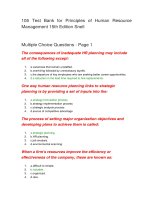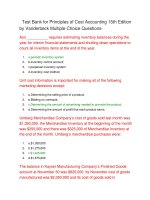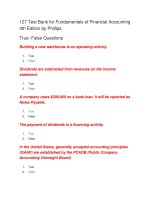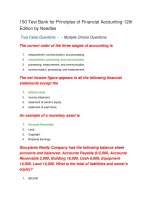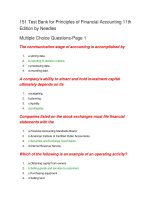Test bank for principles of human anatomy 13th edition by tortora
Bạn đang xem bản rút gọn của tài liệu. Xem và tải ngay bản đầy đủ của tài liệu tại đây (300.9 KB, 8 trang )
Test Bank for Principles of Human Anatomy 13th Edition by Tortora
Full file at />Package Title: Clickers
Course Title: pha13e
Chapter Number: 01
Question type: Multiple Choice
1) Which subdiscipline of anatomy examines the microscopic structure of tissues?
a) cell biology
b) histology
c) surface anatomy
d) gross anatomy
e) regional anatomy
Answer: b
2) Which of the following are the smallest living units in the human body?
a) atoms
b) cells
c) molecules
d) organs
Answer: b
3) A system in the body is composed of related _______ with a common function.
a) atoms
b) cells
c) molecules
d) organs
e) tissues
Answer: d
Full file at />
Test Bank for Principles of Human Anatomy 13th Edition by Tortora
Full file at />4) Which organ system is shown in the figure?
a) respiratory
b) cardiovascular
c) lymphatic
d) digestive
e) endocrine
Answer: e
5) Which of the following is an important life process of humans?
a) responsiveness
b) metabolism
c) differentiation
d) movement
Full file at />
Test Bank for Principles of Human Anatomy 13th Edition by Tortora
Full file at />e) All of these choices are important life processes of humans.
Answer: e
6) When the human body is in the anatomical position, the palm of the hand faces:
a) forward.
b) laterally.
c) medially.
d) posteriorly.
e) superiorly.
Answer: a
7) Which of the following is NOT part of the trunk?
a) abdomen
b) chest
c) neck
d) pelvis
e) abdomen and pelvis
Answer: c
Full file at />
Test Bank for Principles of Human Anatomy 13th Edition by Tortora
Full file at />8) In the figure shown, which anatomical descriptive form is indicated?
a) inguinal
b) buccal
c) antebrachial
d) mental
e) axillary
Answer: e
9) Which of the anatomical planes listed below are vertical ?
1. frontal
2. midsagittal
3. oblique
4. parasagittal
5. transverse
a) 1, 2, 4
b) 2, 4, 5
c) 3
d) 4, 5
Full file at />
Test Bank for Principles of Human Anatomy 13th Edition by Tortora
Full file at />e) 5
Answer: a
10) In the figure shown, the carpals are ______ to the humerus?
a) anterior
b) posterior
c) proximal
d) distal
e) superior
Answer: d
Full file at />
Test Bank for Principles of Human Anatomy 13th Edition by Tortora
Full file at />
11) In the figure shown, which anatomical region contains the esophagus, heart, trachea, and
thymus?
a) diaphragm
b) mediastinum
c) peritoneum
d) lungs
e) None of these choices
Answer: b
12) The meninges line which of the following body cavities?
a) thoracic cavity
b) abdominal cavity
c) vertebral (spinal) cavity
d) pelvic cavity
e) plural cavity
Answer: c
Full file at />
Test Bank for Principles of Human Anatomy 13th Edition by Tortora
Full file at />
13) In the figure shown, which abdominopelvic region contains the urinary bladder?
a) epigastric region
b) hypogastric (pubic) region
c) left inguinal (iliac) region
d) right lumbar region
e) umbilical region
Answer: b
14) Inspection, palpation, auscultation, and percussion are techniques used when performing:
a) a medical history.
b) a physical exam.
c) medical imaging.
d) epidemiology.
Full file at />
Test Bank for Principles of Human Anatomy 13th Edition by Tortora
Full file at />e) pharmacology.
Answer: b
15) Which of the following BEST reveals the physiology of a structure?
a) computed tomography (CT)
b) magnetic resonance imaging (MRI)
c) positron emission tomography (PET)
d) endoscopy
e) ultrasound scanning
Answer: c
Full file at />

